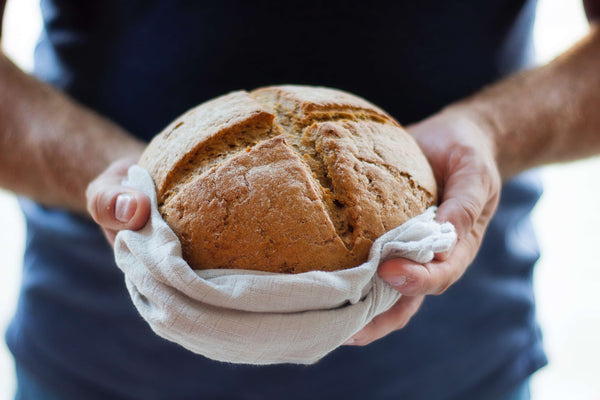
Inhaltsverzeichnis
This is how you stood up to your foods properly!
“What belongs in the fridge and what doesn't? Should I keep it in its original packaging or pack it myself?” “What can be stored together?”
I regularly stumbled upon these questions when I first moved into my own apartment. And I'm still sometimes unsure how to properly store certain foods. Proper storage, especially for fruits and vegetables, is very important: Proper storage of food makes it last longer and keeps it fresh. If your food spoils, you're not only throwing money away, but you're also contributing to food waste.
Learn how to store food properly.
The purchase
Shopping selectively can save you a lot of spoiled food. Planning ahead a little bit about when, how much, and exactly what you're buying not only makes shopping easier but also significantly increases the chances that the food will "survive" and stay fresh until consumption. If you're not sure exactly when you'll be able to eat certain foods, it's a good idea to buy frozen and portion-sized products.
Especially for those of us who like to shop spontaneously and are inspired by the supermarket shelves, targeted shopping can be a real challenge. As with everything, practice makes perfect. If you write shopping lists or take half an hour on Sunday evenings to roughly plan your meals for the next week, you won't have to run to the supermarket every (other) day, you'll spend less money, and you'll be more mindful of your diet. You'll see, it's worth it!
Store food properly
Most foods, if stored properly, will keep for at least a few days. Homemade sauces, dips, jams, and the like usually need to be consumed more quickly, within about two days (of course, this only applies to non-preserved items). The refrigerator is a great help in this regard. Unfortunately, we usually only realize how much it really does for us during a power outage. In any case, refrigerators have different cooling zones – because some foods prefer it warmer, while others prefer it colder:
- In the bottom of the refrigerator There's usually a vegetable compartment. This is kept at six to eight degrees Celsius, which is an ideal temperature for most fruits and vegetables. You'll find out which varieties are exceptions below.
- The Shelf above the vegetable compartment (often a glass shelf) is suitable for storing perishable foods such as meat and fish. It's coldest here, between zero and five degrees Celsius. This shelf can also be used for gentle defrosting.
- The Middle of the refrigerator At 4-5 degrees Celsius, it's slightly warmer than the compartment below. Dairy products like cheese and yogurt thrive here.
- In the upper part Open canned goods, preserves, prepared meals and drinks can be stored at eight degrees.
- In the refrigerator door It's warmest at 10 to 15 degrees Celsius. Eggs, butter, dressings, sauces, as well as milk, water, and juices, are perfectly stored here.
- It is generally recommended to always cover open containers, prepared food and cheese and sausage airtight or to store them in a container. close.
Best before date
The Best before date By the way, the best before date is "only" a recommendation from the manufacturer. If the best before date has been reached, you don't have to throw the food away immediately. In most cases, you can eat it without any problems if it smells good and there is no mold. Use by date However, it's something else entirely. It's often indicated on packaged meats, packaged salads, and similar items. You should always stick to this date, as otherwise you could get sick.

Storing fruit properly
The first rule for all fruits and vegetables is that they should ideally be washed just before consumption. The water makes them more sensitive and causes them to rot more quickly. They are also more susceptible to germs.
For the storage of fruit, the Rule of thumb that domestic varieties prefer it cool and exotics like it warmn. Apples, pears or cherries can therefore be safely stored in the refrigerator. Bananas, mango and citrus fruits on the other hand, like temperatures above 16 degrees and find their place in the fruit bowl. Kiwis and figs are the exception among exotic fruits – they can be kept in the refrigerator.
If an apple is placed near other fruits, they will rot more quickly. Ripening and rotting process In plants, the hormone ethylene regulates the production of ethylene. Apples, as well as plums and apricots, emit particularly high levels of ethylene. Therefore, it is best to store such fruits separately to prevent premature spoilage of the other fruits. If a faster ripening process is desired (z.B. with bananas), it is even a good idea to place the respective fruit next to an apple.
Ripe bananas?
If a banana becomes more brown than yellow, many households throw it in the trash. This doesn't have to be the case. Ripe bananas freeze well and use it for smoothies or nice cream! I cut the banana into several small pieces, put them in a reusable plastic bag, and store them in the freezer. Frozen bananas are great in smoothie bowls: They cool the bowl and give it a wonderfully creamy consistency. Definitely give it a try!
Storing vegetables properly
Most vegetables thrive in the refrigerator. The most popular exception is tomatoesBut also the Potato, eggplant and pumpkin do not like the cold of the refrigerator. Potatoes, in particular, like it dark and well-ventilated, so they can also be stored well in the cellar. The same applies to onions and Garlic.
Whether fruit or vegetables: It is recommended Plastic packaging before storage removeCondensation builds up more quickly in plastic, which causes food to rot faster. Mushrooms, in particular, are best stored in a paper bag or wrapped in a kitchen towel.
Storing bread and baked goods correctly
Sliced Bread Goes moldy faster than half or whole loaves of bread. The best way to store bread is to wrap it in a kitchen towel and place it in a bread bin. It's best to clean the bread bin regularly, as bread crumbs encourage mold growth. If you don't have a bread bin, you can also store the wrapped bread cut-side down on a cutting board in your room. In general, wheat bread doesn't keep as long as rye bread, or bread made from darker flour in general.
If you would like to learn more about healthy eating, mindfulness or sustainability, take a look here over.
Do you have any other tips for storing food properly? Please share them with us!




























Leave a comment
This site is protected by hCaptcha and the hCaptcha Privacy Policy and Terms of Service apply.